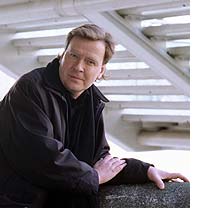Magnus Lindberg interview about Piano Concerto No.2

Magnus Lindberg’s new concerto for Yefim Bronfman is premiered by the New York Philharmonic on 3 May, conducted by Alan Gilbert.
Twenty years have passed since your first piano concerto. What prompted a return to the genre?
I always had in mind the idea of returning to write another piano concerto, but I was first occupied with a series of concertos for other instruments: cello, clarinet and violin. It was when I got to know pianist Yefim Bronfman in New York that things came together. It seemed the ideal situation that the work should be the last major commission under my residency with the New York Philharmonic, as I wanted to write a half hour concerto with full symphony orchestra and I had got to know Yefim’s special pianistic world and the players in the orchestra.
Your first piano concerto explored the French sensibility of Ravel and Debussy: is this the territory of your second?
The first concerto was written for Paul Crossley, an outstanding exponent of the music of Ravel, Debussy and Messiaen, so those composers inevitably shaped that soundworld. Yefim Bronfman also plays French music, but is equally associated with the more muscular works of Bartók and Prokofieff, and the Romanticism of Rachmaninoff, so the second concerto needed to have wider-ranging roots. If the first concerto looks to Ravel’s G major concerto, the second is closer in spirit to his left hand concerto. I also wanted the new work to survey my own pianistic experience, from Kraft in the mid-’80s through Related Rocks to the present.
How does being a pianist yourself influence your writing?
For me, writing for the piano is a direct, physical activity. So, I didn’t want to approach the work in an abstract way, almost ignoring the characteristics of the instrument. The span of the piano repertoire is overwhelming compared to other instruments and comes with a lot of baggage. I worked through a lot of styles when performing as a pianist, including ten years playing in a keyboard duo, and had to get to grips with pieces by Cage, Stockhausen, Berio and Zimmermann. I don’t believe it is easy or even fruitful any more for a composer to invent a completely new universe for the instrument but, rather, the complexity of pianistic history needs to be absorbed into a personal language. I’ve tried to achieve this, not through post-modern style-hopping, but rather through a structure that creates a tension between different modes of expression.
What is the relationship between the soloist and the orchestra?
In my first piano concerto, the constellation of possible relationships is explored, so in the first movement there is a traditional classical dialogue, in the second an extreme opposition between soloist and orchestra, and in the third the orchestra wins the battle subsuming the soloist into becoming an orchestral instrument. However, as I’ve progressed through the cello, clarinet and violin concertos I’ve developed a much less rigid approach. In the new concerto, the piano leads with its own world and the interaction with the orchestra is more about how the material itself is communicated.
How does the soloist’s material reflect the piano’s unusual ability to cover both the vertical and horizontal dimensions?
Of all instruments, the piano can provide everything without the need of the orchestra: chords and melodies, percussive and lyrical writing. So it is definitely the leading voice, stating material or providing rapid passage work, with the orchestra in pursuit. An extreme case of this would be the Lisztian idea of the concerto, but I haven’t gone that far. I haven’t sought extreme virtuosity as an ambition for the solo part, but rather hope the virtuosity is transmitted instead through the music as a whole. As in the Ravel left hand concerto, where there are only eight minutes of tutti in the entire work, I haven’t been afraid to let the soloist play alone. When together, I’ve had to be careful of balance with such a large orchestra, making sure the solo texture is differentiated from that of the ensemble.
How does the concerto relate to traditional three-movement expectations?
Though the concerto runs continuously, there are three clear sections, which evolved naturally during composition. The first presents everything in expository fashion, the second is a contrasting slow movement with cadenza, and the third is a more direct, straightforward finale. The sections are bound together because they all use the same material, but the later movements are not traditional variations of the first. As in the Clarinet Concerto you’ll hear recognisable, exclamatory motives, almost like characters in a drama. The tension and structure comes from the journeys and points of arrival and departure, with blurs and blends of identity as I explored in GRAFFITI.
Do you have any plans to add the new concerto to your repertoire, as you did with the first?
When I wrote the first piano concerto I had no plans to perform it, but then ten years later I accepted the challenge and took a taste of my own medicine. It’s the same here. Who knows what happens in the future – perhaps I may come to regret making it so demanding! That’s why, at present, I’m more than happy to have it safely under the expert fingers of Yefim Bronfman.
Interviewed by David Allenby
Magnus Lindberg
Piano Concerto No.2 (2010-12) 25’
Commissioned by the New York Philharmonic,
Royal Concertgebouw Orchestra Amsterdam
and Gothenburg Symphony
3-5 May 2012 (world premiere)
Lincoln Center, New York
9 May 2012 (US West Coast premiere)
Walt Disney Concert Hall, Los Angeles
Yefim Bronfman/New York Philharmonic/Alan Gilbert
> More info on Magnus Lindberg
> New York Philharmonic
> Lincoln Center
> Further information on Work: Piano Concerto No.2
Photo: Hanya Chlala/ArenaPAL
